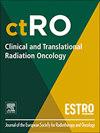Adaptive radiotherapy for oropharyngeal cancer with daily adapt-to-shape workflow on 1.5 T MRI-linac: Preliminary outcomes and comparison with helical tomotherapy
IF 2.7
3区 医学
Q3 ONCOLOGY
引用次数: 0
Abstract
Introduction
MR-linac could offer several advantages for radical radiochemotherapy (RCHT) in oropharyngeal squamous cell carcinoma (OPSCC) patients. Currently, only a few case series have been published and no comparison with other techniques have been performed.
Methods
Data of 34 consecutive patients treated from September 2022 to May 2024 at a single Institution with RCHT on Unity® MR-linac for OPSCC with daily adaptive radiotherapy (RT) according to the adapt-to-shape (ATS) workflow were prospectively analyzed. A comparative cohort of 34 patients with similar characteristics treated with helical treatment on Radixact® was retrieved.
Results
Characteristics were well balanced across the two groups. Maximal toxicity grade ≥2 rate was borderline higher at RT end in MRI-linac group (p 0.049), but lower one month after RT (76.5 % vs 91.2 %; p = 0.257).
Non-significantly lower rates of grade ≥2 xerostomia and dysgeusia were reported in Unity® group one and three months after RT. Higher rates of hospitalizations were reported in Radixact group at 20 fractions and at RT end (64.1 % vs 35.3 %; p = 0.015). Mean Karnofsky performance status (KPS) was higher in Unity group three months after RT (87.67 vs 83.87; p = 0.038).
After a median follow up of 361.5 days, local complete response was reported for 93.6 % of patients treated with Unity® and 96.8 % of patients treated with Radixact®.
Conclusions
Results of this analysis support the feasibility of an ATS MR-linac workflow for RCHT in OPSCC. Compared with tomotherapy, treatment with Unity® resulted in significantly lower rates of hospitalization and higher KPS three months after RT. Grade 2 xerostomia and dysgeusia rates were non-significantly lower in Unity group. Optimal results in terms of local control were reported for both techniques.
在1.5 T mri直线上每日适应形状工作流程的口咽癌适应性放疗:初步结果和与螺旋断层治疗的比较
mr -linac可以为口咽鳞状细胞癌(OPSCC)患者的根治性放化疗(RCHT)提供几个优势。目前,仅发表了少数病例系列,未与其他技术进行比较。方法前瞻性分析2022年9月至2024年5月在同一医院连续接受Unity®MR-linac RCHT治疗的34例OPSCC患者的数据,并根据适应形状(ATS)工作流程进行每日适应性放疗(RT)。我们检索了34例接受Radixact®螺旋治疗的具有相似特征的患者的比较队列。结果两组患者的特征平衡良好。MRI-linac组最大毒性等级≥2的比率在RT结束时处于边缘较高(p 0.049),但在RT后1个月较低(76.5% vs 91.2%;p = 0.257)。Unity®组在放疗后1个月和3个月报告的≥2级口干症和发音障碍发生率无显著性降低。Radixact组在20个分数和放疗结束时报告的住院率较高(64.1% vs 35.3%;p = 0.015)。RT后3个月,Unity组的平均Karnofsky性能状态(KPS)更高(87.67 vs 83.87;p = 0.038)。在中位随访361.5天后,93.6%的Unity®患者和96.8%的Radixact®患者报告了局部完全缓解。结论本分析结果支持了ATS MR-linac工作流程在OPSCC RCHT中的可行性。与断层治疗相比,Unity®治疗导致住院率显著降低,术后3个月KPS更高。Unity组2级口干和发音障碍发生率无显著降低。报告了两种技术在局部控制方面的最佳结果。
本文章由计算机程序翻译,如有差异,请以英文原文为准。
求助全文
约1分钟内获得全文
求助全文
来源期刊

Clinical and Translational Radiation Oncology
Medicine-Radiology, Nuclear Medicine and Imaging
CiteScore
5.30
自引率
3.20%
发文量
114
审稿时长
40 days
 求助内容:
求助内容: 应助结果提醒方式:
应助结果提醒方式:


